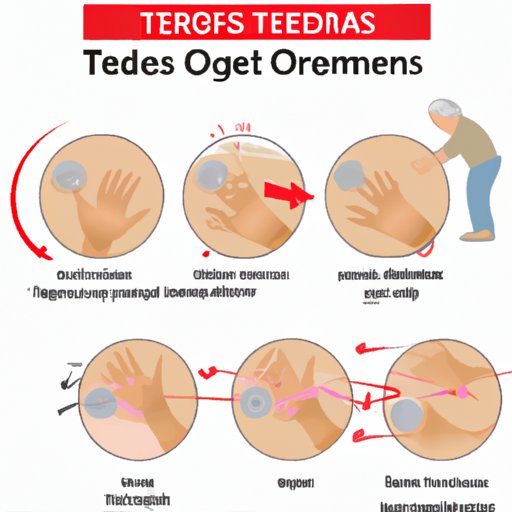Introduction
As we age, we may start to notice changes in our bodies that we never expected. One of the most common concerns for seniors and their loved ones is tremors, or shaking in the body. While it may be a natural part of aging, it can also be a sign of an underlying health condition. In this article, we will explore the science behind tremors in older adults, the different types of tremors, their causes, and available treatment options. We will also discuss the stigma surrounding shaking and provide helpful tips and coping mechanisms for readers dealing with tremors in old age.
The Science Behind Tremors in Older Adults: Exploring the Causes and Treatment Options
Tremors are involuntary movements of the body that can affect the hands, arms, legs, head, or voice. They range from mild to severe and can be caused by a variety of factors. To diagnose tremors, doctors may perform a physical exam, evaluate medical history, and run tests such as blood work or imaging studies.
There are several types of tremors, including rest tremors, action tremors, and essential tremors. Rest tremors occur when the body is at rest, while action tremors occur during movement. Essential tremors, the most common type in older adults, are characterized by involuntary shaking that worsens with age. They can be hereditary and usually start on one side of the body before affecting both sides.
Treatment options for tremors vary depending on the type and severity of the tremor. Medications such as beta-blockers or anticonvulsants may be prescribed to manage symptoms. Occupational or physical therapy may also be recommended to improve muscle control and coordination. In some cases, surgery may be an option to alleviate tremors. Deep brain stimulation, a treatment that involves the implantation of electrodes in the brain, can be effective in reducing tremors.
Understanding Essential Tremors: What You Need to Know About Shaking in Old Age
Essential tremors are a neurological condition characterized by involuntary shaking that can affect various parts of the body. They are different from tremors caused by other health conditions or medications. While the exact cause of essential tremors is unknown, they are believed to be hereditary in about half of all cases. They can also be exacerbated by stress, fatigue, or caffeine intake.
Symptoms of essential tremors can include shaking in the hands, arms, head, or voice. They can affect daily tasks such as writing, drinking, or speaking. While essential tremors are not life-threatening, they can greatly impact quality of life. Treatment options include medications, therapy, or surgery. Coping mechanisms such as stress reduction, regular exercise, and a healthy diet can also be helpful in managing symptoms.
Why Do Senior Citizens Shake? A Closer Look at Neurological Disorders and Age-Related Symptoms
Neurological disorders such as Parkinson’s Disease and multiple sclerosis can cause tremors in older adults. Parkinson’s Disease is a progressive disorder that affects movement and coordination. It can cause rest tremors, stiffness, and slow movements. Multiple sclerosis is a condition that affects the central nervous system and can cause a variety of symptoms, including tremors.
Age-related changes to the nervous system can also contribute to tremors in older adults. As we age, our brains may have difficulty controlling movements and muscle contractions. Diseases such as Alzheimer’s or dementia can also contribute to tremors.
Other health conditions or medications can also cause tremors in seniors. For example, low blood sugar, thyroid disorders, or certain antidepressants can contribute to shaking. It is important to speak with a healthcare provider to determine the underlying cause of tremors and develop an appropriate treatment plan.
Shake it off? Not So Fast: Debunking Myths About Elderly Tremors and Dispelling Stigma
One of the biggest misconceptions about tremors in older adults is that they are a normal part of aging. While tremors can be more common in seniors, they should not be shrugged off as an inevitable consequence of getting older. Another myth is that tremors are a sign of mental decline, which is untrue. It is important to recognize that tremors are a medical condition that require evaluation and treatment.
There is often a stigma attached to shaking, which can lead to social isolation and decreased quality of life. It is important to address the stigma and educate others about the science behind tremors. By raising awareness, we can help reduce the negative impact of shaking on individuals and communities.
Coping with Tremors in Your Golden Years: Helpful Tips and Techniques for Managing Shaking and Other Movement Disorders
If you or a loved one is dealing with tremors in old age, there are several lifestyle changes that can help alleviate symptoms. Exercise, particularly activities that improve muscle strength and balance, can be effective in reducing tremors. Stress reduction techniques such as yoga or meditation can also be helpful. A healthy diet and regular sleep can also improve overall wellbeing.
Assistive devices such as weighted utensils or writing aids can make daily tasks easier. Occupational or physical therapy can also provide strategies for improving movement and coordination. Emotional support and social connection, whether through support groups or spending time with loved ones, can also improve overall quality of life.
Conclusion
Tremors can be a concern for seniors and their loved ones, but there are effective treatment options available. By understanding the science behind tremors, debunking myths, and providing helpful tips for coping with the condition, we can empower individuals and reduce the negative impact of shaking on quality of life. If you or a loved one is experiencing tremors, speak with a healthcare provider to determine the underlying cause and develop an appropriate treatment plan.
